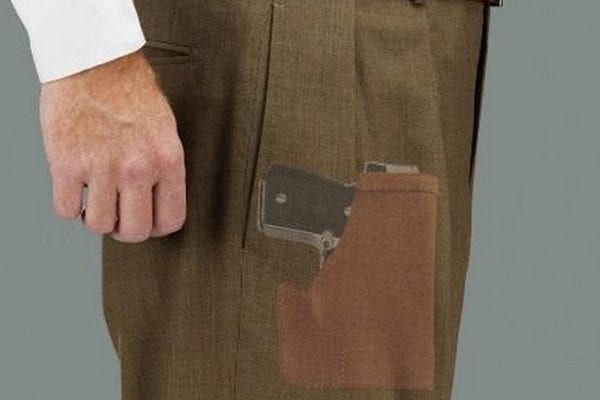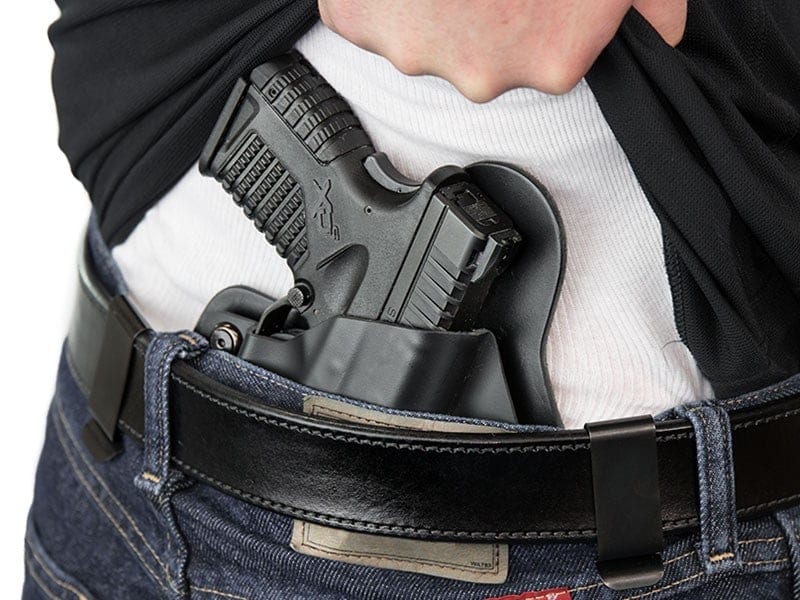As the number of concealed carriers builds exponentially due to access to information, increased pressure on state gun regulations, a robust market of accessories, and a push from manufacturers to make products for the buyers of concealment products, it becomes important to understand which concealed carry position is the best for most shooters.
This article discusses the most widespread techniques for carrying, and why each of them makes sense (or doesn’t) for you. We cover popular styles of carrying and you’ will learn some unique benefits and disadvantages other articles may not even cover.
The Best Concealed Carry Positions
Let's take a look at some of the most popular concealed carry positions and our top holster picks per!
We cover Appendix Carry, IWB, OWB, Ankle, Shoulder, and Pocket carry techniques and go into the comparative value of each style. You might be quite surprised if you’ve only ever tried a single carry style - read on, to see what each style offers.
Review of the Best Concealed Carry Holsters by Position
Appendix Carry
Appendix holsters are super popular these days with a large number of new holster materials (like Kydex) and styles that can benefit the carry style.

Appendix Carry (Source)
It essentially involves a proven method of carrying a weapon halfway between a direct center position and the front hip position on your body, near where the appendix is located (hence the name).
Advantages
- Concealment: Appendix carry offers good concealment for a wide range of body types and clothing styles because of its location, in the soft area between the hard hip, and the apex profile position of your zipper area.
- Easy Access: You can get to your firearm from a variety of positions, including seated (see the caveat below), standing, or driving.
- Good retention: Because it is positioned in a place where a natural tension exists, and there is no bone to rub against (like the hip bone), your firearm can easily be retained.
Disadvantages
- Comfort while seated: As in – it’s not comfortable while seated.
- Access if you’ve got a larger abdomen: As in – limited access for large abdomens.
- Potential safety concerns: As in – it could be dangerous unless you take precautions because the barrel of the gun points towards your crotch and the biggest artery in your body.
Outside the Waistband (OWB)
Outside the waistband holsters make sense for most users, especially those who need full-time, easy access to their firearm, and for those who are larger, or carry a little more weight, or have a large midsection.

Outside the Waistband (OWB) (Source)
Advantages
- Quick access: if you need to get to your firearm fast, this is the concealment position for you.
- Comfort: you will have a much easier time carrying an OWB holster in most cases, due to the high level of comfort (provided you have a belt capable of holding up your pants).
- Safety: Most OWB holsters have exceptional retention and safety considerations built in.
Disadvantages
- Harder to conceal: The OWB can print easier if you are not wearing certain clothing, or if you have a large holster or firearm.
- The gun can snag on things: If you aren’t vigilant about your carry, it can get annoying when you run into things while moving, or your shirt gets hung up on the top of your rig.
- It’s not the best holster when driving: Plan on being uncomfortable with an OWB in a car. Especially if you carry on your right side and drive the vehicle – annoying is an understatement.
Inside the Waistband (IWB)
The inside the waistband holster is the current go-to for most carriers in decent shape. For those who don’t have a belly, this is the easiest to conceal (full-time) carry methodology, easy to access and safer than most positions.
Advantages
- Great concealment: You can rest assured you aren’t going to print, with most situations and most guns unless you’re in an awkward situation, and/or in tight clothes.
- Solid retention: The waistband and belt will pin your holster to the exact place you want it. It’s built into the system.
- Fewer snags: You won’t have as many hiccups when carrying full time and it says a lot about why this method of carrying makes great sense for so many people.
Disadvantages
- Slower on the draw: You will have a fraction of a second longer for the draw (maybe significantly more).
- Comfort isn’t the IWB’s strongest suit: It’s not super comfortable to carry on your hip under your waistband.
Ankle Holsters
The ankle holster is a significant option for a backup gun, or for those who need legitimate concealment and aren’t doing a ton of extraneous movement. Most ankle holsters are only well suited to smaller guns.
Advantages
- A near perfect selection for dress attire: This is an acceptable carry method/placement for those who need to have a gun during work in an office environment, or who have to have good concealment in dress pants.
- Gives you a second option: A wise group of highly trained individuals once went by the mantra - for every situation one is none, two is one.
- Comfort: Not getting poked in the gut or having a hunk of heavy metal riding on your hip bone has its advantages.
Disadvantages
- You need to be stationary for a draw: you cannot be moving and expect to draw.
- You cannot exercise or run with an ankle holster: You will either lose your weapon, get a bruised-up ankle, or be frustrated with the outcome of the choice to run/exercise.
- When your pants ride up your gun is viewable: Don’t cross your legs unless you’re in a board meeting where everyone already knows you’re carrying, because you’ll be outed by your totally exposed firearm.
Shoulder Holsters
By far, this is the most comfortable all-around holster for someone who needs instant access to their gun, needs to be able to move quickly, and doesn’t mind that people can easily see your rig in most conditions.

Drawing gun from a shoulder holster (Source)
Advantages
- Super comfortable: After it’s been worn for a bit, it will feel like an extension of your body. The weight is always distributed evenly, even with a very heavy gun.
- Easy access: You can grab your gun quickly, even while moving, seated, in a car, in an office, or while running fast. You can easily grab your gun. Period.
- Easy to conceal in a suit (or with a jacket buttoned up).
Disadvantages
- Not so easy to conceal for those who see you every day: you will be outed when you move with an open suit jacket or take off your jacket on a hot day.
- Safety concerns: Your gun is not always pointed in a safe direction depending on your surroundings.
Pocket Holsters
Pocket holsters are an interesting option. You can carry extra firepower with easy concealment, and with the right pockets and the right gun, you can carry your primary weapon with few drawbacks.

Pocket Carry with Pocket Holsters (Source)
Advantages
- Incredibly easy to hide: No one will know you’re carrying if you’re wearing jeans (unless they are skinny jeans) and using a reasonably sized gun.
- Super comfortable: If you wear a belt, you won’t be bothered by the gun in your pocket.
Disadvantages
- Slower draw: unless you go without a holster, which we don’t recommend because it’s not safe and doesn’t offer much concealment.
- Fewer holster options: There aren’t a ton of options, so pay attention to the one below because it’s pretty good.
What is the Most Comfortable Carry Position?
There is no right answer – only a ton of variables.
However, if you want the king of balance, and can keep it concealed, or don’t care much for day to day concealment as much as other needs; a shoulder holster is a fantastic option.
Most people would smirk at such a recommendation, but the balance is exceptional.
Of course, you give up the overall concealment of the holster in exchange for such balance.
You can do anything in it, including sitting in a car for long periods of time and exercise like running. If you want a good performance holster with exceptional comfort, this is the one.
But go into it knowing you are compromising true concealment by utilizing the shoulder holster.
Want something that’s very comfortable, and exceptionally concealable too? You could opt for a pocket holster.
You might get push back from some folks on this suggestion as well, but when you look at the reality of the matter, you get the comfort, carrying capacity, (given the right belt, pants, and gun combination) and absolute concealability. What more could you want?
If you are stationary, like sitting at a desk most of the time, an ankle holster takes the cake for concealment and comfort, but don’t dare to run in it.
You’ll get premium comfort and concealability, but without a bunch of great options. Additionally, this holster will not move well with activities.
Conclusion
The best concealment position is about the most comfortable carry style. Sure, there are other variables, but that is the king. Why? Because you need to be able to do it all day; every day when you are outside your home.
Sure, you could argue that concealment is AS important, but you’d be wrong. Concealment is important, but it’s secondary.
The truth is: you can get away with being found out as a concealed carrier. What you cannot do, is be forced to be without your gun because of discomfort or difficulty in carrying.
So, while you want to have a great balance of all the important aspects of firearm carrying, rest assured the comfort factor is the number one thing you’re looking for.
If you understand this position, you will want to opt for a shoulder holster, pocket holster, or ankle holster, if you can stomach the slower draw capabilities.
If you prioritize draw timing and ease of access, opt for the other variants. Like we mentioned earlier: There is no right answer – only a ton of variables.





